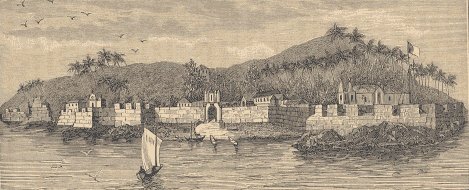Anjadip Island is situated in the tranquil water of the Arabian Sea in South Goa. This island lies on the coast of islands in Karwar. This island is also known as Anjadiv Island. This island is near the Karnataka Border but is part of Goa. The island is extended in 1.5 square km. This island is home to the Indian Navy. Indian Navy has a ship named INS Anjadip. Anjadip Island offers a blend of natural beauty, history, and cultural significance, making it a must-visit for travelers seeking an offbeat destination away from the typical tourist trails.
Table of Contents
History of Anjadip Island
Anjadip Island has a rich history. Portuguese lived here from 1498 AD to 1961 AD. Portuguese used this island for centuries as a watering station for their ships. Vasco de Gama visited this island in 1498 and later in 1502. It was also the site of the Our Lady of Springs Church, which was built in the early 16th century. The church has become a symbol of the island’s spiritual and cultural heritage.

The Portuguese established themselves as a dominant maritime power along India’s western coast in the 16th century, and Anjadip Island became one of their strategic points. The island’s historical ties to Portuguese rule give it a unique cultural flavor that blends both Indian and Portuguese influences. Additionally, the island was involved in one of the key events leading to the liberation of Goa in 1961 when the Indian Navy launched “Operation Vijay” to free the region from Portuguese control. This historic event adds a layer of importance to Anjadip Island’s legacy.
Anjadip Fort
Anjadip Fort tells the tale of Portuguese conquest, maritime dominance, and religious influence in India. Anjadip Island is significant for its natural beauty, and also for its historical and cultural relevance. The construction of Anjadip Fort began in 1505, under the orders of the Portuguese governor Francisco de Almeida. The fort was primarily built to protect Portuguese territories from rival European powers and local Indian rulers.
The fort played a significant role during several key events in history, including the early years of the Portuguese empire in India and the expansion of their religious and military activities. Apart from being a military structure, Anjadip Fort also had religious significance. The island was home to the Our Lady of Springs Church, which was the first chapel built by the Portuguese in India.
The fort saw occasional use in later years, particularly during moments of conflict involving Goa and neighboring regions. Still, its strategic value had largely diminished when India gained independence. In 1961, Anjadip Fort fell under the control of the Indian government, and today, it stands as a historical relic, much of it in ruins. The remains of Anjadip Fort showcase typical Portuguese fortification techniques, including high stone walls, bastions, and watchtowers designed to provide extensive views of the surrounding waters.
Tourism
Anjadip Island boasts unspoiled natural beauty, with its pristine beaches, clear waters, and lush greenery. Nature lovers and eco-conscious travelers can explore the island’s biodiversity and enjoy activities like bird watching, coastal hikes, and scenic photography. Its natural charm offers a stark contrast to the bustling beaches of Goa, providing a more intimate connection with nature.
Travelers visiting Goa occasionally visit this Island. The island is renowned for its annual Nossa Senhora da Brotas Festival, held on February 2, and for the celebration of St. Francis D’Assisi Chapel Day, which takes place on October 4. The island is smaller compared to the more famous St. Mary’s Island or Netrani Island but carries a distinct historical and cultural significance.

Anjadip Island is a haven of peace and serenity. It is enveloped by lush greenery, rocky shores, and pristine waters, making it ideal for a quiet getaway. The surrounding waters are crystal clear, and the island’s natural landscape provides breathtaking views of the Arabian Sea. The surrounding waters are crystal clear, and the island’s natural landscape provides breathtaking views of the Arabian Sea.
Today, Anjadip Island is controlled by the Indian Navy, and access to the island is restricted due to its strategic location near the Karwar Naval Base. Its naval presence has helped preserve the island’s pristine condition, protecting it from over-tourism and commercialization.
Anjadip Island’s location, near the tourism hotspots of Karwar and Goa, makes it a strategic addition to itineraries for travelers exploring India’s western coastline. Anjadip Island Karwar, with its pristine beaches, and Goa, with its vibrant culture and historic sites, are popular tourist destinations. Anjadip Island serves as an offbeat destination for those who want to step off the well-trodden path and discover a lesser-known gem in the region.
Nearby Locations
Travelers can also explore other attractions in Karwar and Goa during their visit to the Anjadip Islands. The stunning Karwar Beach is perfect for a relaxing day by the sea with its soft sand and gentle waves. The Sadashivgad Fort in Karwar offers panoramic views of the surrounding coastline. Devbagh Beach is famous for its scenic beauty and water sports. In Goa, popular beaches like Palolem and Agonda are only a short distance away, making Anjadip Island an excellent stop on a broader coastal itinerary.
How to Reach
Tourists can visit Anjadip Island with the help of buses, Cab, or Rental Bikes. It is situated 8 km away from Karwar Bus Station. Tourists can reach them with the help of Boat also. Anjadip Island may be small in size, but it is rich in history, culture, and natural beauty. Its unique blend of Indian and Portuguese heritage, coupled with its serene environment, makes it a standout destination for those looking to explore the less commercialized parts of India’s western coastline.
While the distance from Karwar to Goa is 80 to 100 km. From Goa go need to cover this distance to reach Anjadip Island.
Nearest Airport
Dabolim Airport (Goa) is the nearest airport to Anjadip Island, approximately 85 km away from Karwar. After reaching Dabolim, you can hire a taxi or take a bus to Karwar. The drive from Goa to Karwar takes around 2 hours along the scenic coastal highway.
By Train
The closest railway station to Anjadip Island is the Karwar Railway Station, which is about 12 km away from the Karwar port. Karwar station is well-connected to major cities like Mumbai, Bengaluru, and Goa. You can take a taxi or an auto-rickshaw from the station to reach the Karwar port.
By Road
From Goa
Anjadip Island is roughly 85 km from Panaji, the capital of Goa. You can drive down from Goa to Karwar via National Highway 66, which offers a scenic coastal route. Several private and government buses also operate between Goa and Karwar.
From Bengaluru
If traveling from Bengaluru, Karwar is approximately 520 km away. You can take a direct bus or drive via National Highway 48, then switch to NH 66. The journey by road takes about 10 hours.
From Mumbai
The distance between Mumbai and Karwar is around 650 km, with buses and trains running between the two cities. The drive via NH 66 takes about 12-13 hours.
By Boat from Karwar
Once you reach Karwar, you need to arrange for a boat to take you to Anjadip Island. The island is located about 8 km offshore.
Permission
If you wish to visit Anjadip Island, contact the Indian Navy or local authorities in advance to inquire about the possibility of getting permission. As the island is part of a naval base, access is tightly controlled, and only certain religious or historical visits are permitted.




